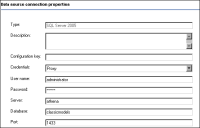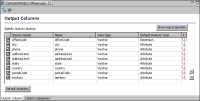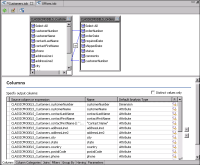Creating information objects with the IO Design perspective
Before you can actually create an information object, you must perform a series of tasks to connect to a data source and prepare the data for use in the information object. This section describes generally all the key tasks involved in creating an information object and other required objects. For detailed information about each task, see Designing BIRT Information Objects.
How to create an information object
1 Create an information object project. An information object project organizes all the files required for the creation and use of information objects. You can create one project for all the information objects and their related objects, or you can organize information objects in multiple projects.
2 Create a data connection definition. A data connection definition specifies the properties to connect to a data source, as shown in
Figure 14‑4. The properties include the data source type, user name, and password. A data connection definition file name has a .dcd extension.
Figure 14‑4 Defining a data connection
3 Create a map. A map, as shown in
Figure 14‑5, represents the data in a discrete entity, for example, a single database table, a result set that a stored procedure returns, or an XML file or flat file. A map file name has a .sma extension.
Figure 14‑5 Creating a map by selecting an offices table
4 Create an information object using data from one or more maps. You also can build an information object from other information objects.
Figure 14‑6 shows an information object that uses data from two maps. An information object file name has a .iob extension.
Figure 14‑6 Defining an information object
The tabs at the bottom of
Figure 14‑6 represent the different ways you can manipulate the data in an information object. For example, to organize columns in categories, choose Column Categories. To limit the data that the information object returns, choose Filters.



